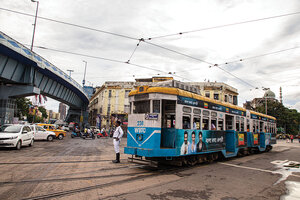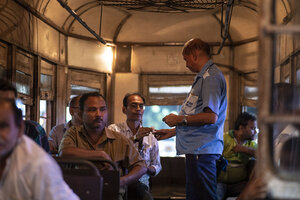In Pictures: On Kolkata’s trams, a journey through the city’s ‘soul’

At its peak, the electric tram in Kolkata, India, operated on 52 different routes. Though just two lines remain in service today, the system is getting fresh support from climate activists as an affordable, eco-friendly transportation option.
Ahmer Khan
KOLKATA, INDIA
As electric trams slowly rumble through the vibrant neighborhoods of Kolkata, formerly known as Calcutta, they take the passengers on a journey back in time. Part of the cultural fabric of the city for more than a century, the tram system has been allowed to atrophy for a lack of riders. Now, enthusiasts and climate activists are fighting to keep tram service as an eco-friendly transportation option.
“Trams are a great way to reduce emissions in the city,” says Debasish Bhattacharyya, president of the Calcutta Tramways Users’ Association (CTUA). “In a time of climate crisis, we need to embrace modes of transport that are sustainable and efficient.”
The first horse-drawn trams appeared in the 1880s, during British colonial rule; next came steam-powered cars. Electrified trams arrived in the early 1900s. They were a popular and inexpensive means of travel.
Why We Wrote This
Kolkata’s aging trams point toward a climate solution – but more importantly, for others, they also provide a reminder of a “simpler and slower” time.
“I have been riding trams for as long as I can remember,” says Pranab Chakraborty, who is in his 70s. “It reminds me of my childhood, when life was simpler and slower.”
For about 15 rupees ($0.18*), trams offer a window into the city’s past of colonial buildings, grand mansions, beautiful bookstores, and old markets. Traveling this way offers passengers an opportunity to sample local cuisine, from savory street foods to traditional sweets.
As Mr. Chakraborty puts it, “The trams may be old, but they are still an integral part of Kolkata’s soul.”
Editor's note: This photo essay has been updated to correct the U.S. dollar value of the tram fare. Fifteen rupees is the equivalent of $0.18.


